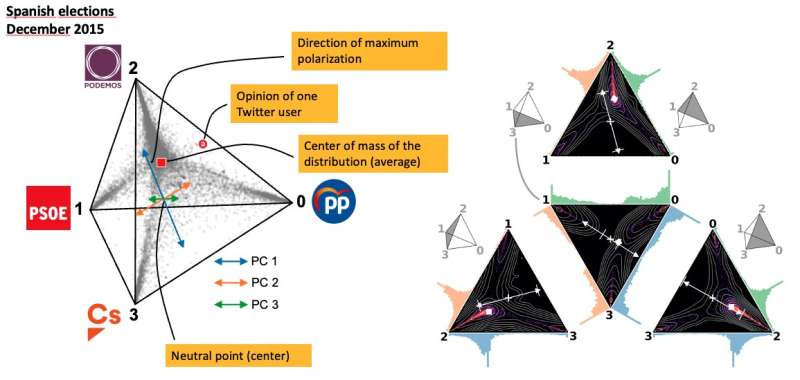A new approach to measuring and understanding multidirectional polarization

Germany, India, Mexico, and Spain. As multiparty democracies, these countries present a more complex picture of what brings people together—or divides them. Using social media data, a group of researchers proposes a novel approach to measuring polarization in nations with multiple political parties.
Complexity Science Hub scientist Samuel Martín-Gutiérrez and his colleagues developed a model that infers opinions from social networks, and measures the left-right political division, as well as other more nuanced sources of tension. They analyzed Twitter data from the Spanish elections of 2015 and 2019.
“It’s important to understand polarization in our society, and our findings shed new light on how political beliefs are shaped,” says Martín-Gutiérrez. “Our approach can lead to useful insights when applied to real-world debates happening on social media.”
The findings of the study were recently published online in the journal Chaos, Solitons & Fractals.
Neutral and unbiased
A key characteristic of the model, according to Martín-Gutiérrez, is its neutrality and unbiasedness. “We assumed we didn’t know anything about the [main Spanish] political parties in the study. And our findings demonstrate that a rigid classification of parties into pre-defined dimensions may not paint the most complete and accurate picture.”
Using Twitter data from two elections, Martín-Gutiérrez and his colleagues from the Universidad Politécnica de Madrid tested the proposed approach in practice. First, they explored the Spanish general elections of December 2015. In a second moment, they dissected the Spanish general elections of April 2019.
“In 2015, we had four opinion poles corresponding to the four main political parties: People’s Party (PP), Spanish Socialist Workers’ Party (PSOE), Podemos, and Citizens (Cs). In 2019, we have five opinion poles, with the addition of Vox,” explains Martín-Gutiérrez.

As a first step, the team identified the opinion leaders, and their ideological positions, on Twitter. “The second step was to analyze the listeners, the interesting part of the network, and assign an opinion to a user according to the average opinion of the people they retweet,” says Martín-Gutiérrez.
Since the social spectrum is more complex and colorful than black and white, the researchers determined the same distance between every pair of poles to avoid bias. “In some contexts, it may seem more appropriate to place certain poles close together. For example, in an election certain political parties may be more ideologically aligned with each other than with the rest. However, parties that share ideology also compete for the same electoral base, often leading to even greater antagonism between them,” explain the authors of the study.
New knowledge
According to them, the opinion patterns of both analyses were consistent with the underlying Spanish social reality and could be interpreted taking into account their context. “There is a clear picture of the Spanish political spectrum, and we can see, for instance, where the opinion distribution is most stretched or where the average opinion is located,” says Martín-Gutiérrez.
“Our findings seem to be in line with what we intuitively know about Spanish politics. From this we can start building new knowledge, for instance, about citizens’ perceptions of politics and their behavior.”
An interactive version of the opinion distribution of the 2015 Spanish elections can be found at here.
The approach could be used in a variety of situations to identify the main points of disagreement. It could also be used in countries with two-party systems, such as the US. The primaries, a key part of the American voting system, are an excellent example, points out Martín-Gutiérrez. “There are several candidates in the presidential state primaries. Our model could be helpful in tracking and understanding how party members’ opinions are distributed,” says the CSH researcher.
The proposed method could also assist policymakers in dealing with polarization and healing social rifts. “It could help policymakers devise de-escalation interventions by addressing the issues that cause the strongest tensions,” argue the authors of the study.
Furthermore, it could be used to combat online misinformation spread by bots and trolls. The model could be used to evaluate the influence automated bots have on social media as compared to real human accounts.
More information:
Samuel Martin-Gutierrez et al, Multipolar social systems: Measuring polarization beyond dichotomous contexts, Chaos, Solitons & Fractals (2023). DOI: 10.1016/j.chaos.2023.113244
Citation:
A new approach to measuring and understanding multidirectional polarization (2023, March 16)
retrieved 16 March 2023
from https://phys.org/news/2023-03-approach-multidirectional-polarization.html
This document is subject to copyright. Apart from any fair dealing for the purpose of private study or research, no
part may be reproduced without the written permission. The content is provided for information purposes only.
For all the latest Science News Click Here
For the latest news and updates, follow us on Google News.

